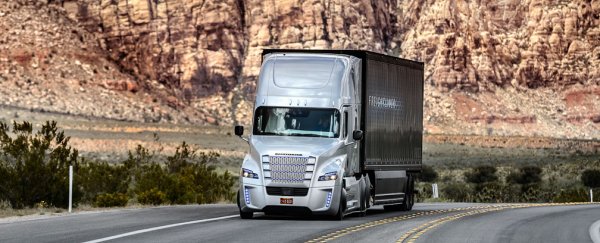The onset of automated services like robots and self-driving vehicles hold the promise of making so many aspects of our lives easier, but that convenience will come at a cost. Experts are predicting fundamental changes to the job market in the next 20 years, as robotic and automated services take the place of jobs once performed by people.
According to a new report by Rachel Nuwer at the BBC, truck drivers are likely to become one of the first endangered occupations due to advances in self-driving technologies, and the elimination of this one role alone has the potential to cause major upheaval in the American job market.
In the latest figures provided by the American Trucking Associations, the nation's trucking industry employs more than 7 million people in total, with 3.4 million being drivers and the rest in ancillary positions that don't entail being behind the wheel. Those are some huge numbers, but even more astonishing is this graph based on 2014 US census data, which highlights just how fundamental the occupation is in the US workforce: truck driver is the most common job in 29 US states.
As Nuwer points out, the reasons behind truck driving's popularity are simple. While it might not be anybody's idea of a dream job – due to long hours on the road and plenty of isolation – truck driving gigs are often available, they pay decently enough, and the line of work has so far remained immune to the creep of automation that has done away with roles like bank tellers and secretaries.
But that's all expected to change in the near future, with partially self-driving long-haul delivery vehicles like Daimler's Freightliner Inspiration (pictured above) already on US highways. The Freightliner Inspiration made history this year, becoming the world's first autonomous truck licensed to drive on public roads in the US, but it certainly won't be the last.
While the Freightliner Inspiration is only a partly autonomous vehicle (still retaining a driver who can take control when required, such as off-highway motoring), fully automated vehicles are believed to not be too far away. Advocates for self-driving trucking say the technology will be cheaper, safer and better for the environment, although nobody knows for sure what will happen when millions of human drivers can't find work in one of the world's most popular jobs.
Earlier in the year, researchers from Oxford University in the UK estimated that as much as 47 percent of the US workforce is at high risk of being replaced by automated technologies in the next 20 years, as the efficiency and complexity of robots evolve.
"Increasingly, algorithms are able to perform not just routine manual labour in the way they have done in the past but also cognitive labour in a way that makes it much more difficult to draw that line between what is automatable and not," said Michael Osbourne, one of the authors of the study, in an interview with Matt Eaton and Nance Haxton of the ABC.
"We found there was a very clear, strong trend between the creative content of a job and its probability of computerisation and replacement by robots. That is, the more creative you are, the more safe you are from automation."
